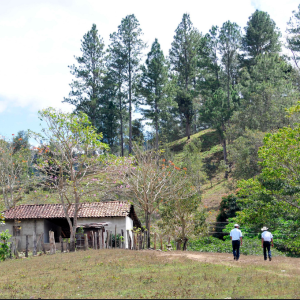
In this information note from the CGIAR programme on Climate change, Agriculture and Food security (CCAFS), researchers present a rough estimate of the proportion of global agricultural emissions that can be attributed to smallholder farmers in developing countries.
On a global scale, nearly a quarter of annual greenhouse gas emissions come from agriculture, forestry and other land use, around ~10-12 GtCO2eq per year (Smith et al. 2014). The authors (and FCRN members) Sonja Vermeulen and Eva Wollenberg here show that, as a rough and high-end estimate, smallholders in developing countries, defined as those with less than 2 ha of farmland, produce approximately 5% (2.5 GtCO2e) of total global greenhouse gas emissions. This is 31% of the total emissions arising from agriculture and land use change (LUC) including deforestation globally and 47% of those emitted from agriculture in developing countries specifically. When excluding LUC and deforestation and looking only at on-farm emissions, smallholders in developing countries contribute to 3.5% (1.7 GtCO2e/yr) of total global greenhouse gas emissions, 32% of total direct emissions arising from agriculture globally and 42% of the agriculture sector emissions from developing countries. The majority of smallholder agricultural emissions – 71% – comes from only three countries: China, India and Indonesia, unsurprisingly given their population size.
| Agricultural emissions from smallholders in developing countries | GtCO2e | % of total global emissions | % of total global agriculture related emissions | % of agriculture related emissions in developing countries |
| On farm (direct, e.g. soils, livestock etc.) | 1.7 GtCO2e/yr | 3.5% | 32% | 42% |
| When including indirect emissions (land use change and deforestation) | 2.5 GtCO2e/yr | 5% | 31% | 47% |
The authors note that the true output of emissions however, is likely to be lower as the smallholder related 2.5 GtCO2e is based on a country’s average emissions per hectare. When looking only at direct agriculture related emissions and excluding LUC (1.7 GtCO2e/yr) a lower-end conservative estimate is that smallholder agriculture generates only half the calculated amount, 0.85 GtCO2e/yr.
Note that a recently published paper by Herrero et al. finds that small and medium farms are also major providers not just of food (51-77% of the global total) but of nutritional diversity. This perhaps would suggest that smallholder systems may deliver fairly good nutritional value in relation to their environmental ‘cost’, although of course the methodologies of the two studies are different.
The report also includes estimates of emissions from net deforestation associated with smallholder agriculture. On a global scale agriculture drives between 70-80% of net emissions from deforestation. Here Wollenberg and Vermeulen use 2010 data to show that, the 20 developing countries with highest net deforestation emissions associated with smallholder agriculture, are responsible for 1.9 GtCO2e/yr, largely driven by agriculture, both commercial and smallholder. This accounts for 70% of all reported global emissions associated with net forest cover change in 2010.
From these 20 countries with high net deforestation emissions they also show that smallholders are responsible for 0.8 GtCO2e/yr which amounts to 42% of all agriculture-driven emissions associated with net forest cover change in those 20 countries. Lastly, deforestation caused by smallholders in all developing countries make up 30% of the global land use change caused by agriculture (based on Hosonuma et al 2012). This percentage (30%) is however likely to decrease in future, as analyses of drivers and trends show that the contribution of smallholders to deforestation is declining globally. It is important to emphasise that this analysis is based on the 20 developing countries with highest net deforestation emissions associated with smallholder agriculture, and so the total global deforestation related emissions from smallholder farms would be higher than 0.8 GtCO2e.
Since data availability varies in many developing countries and there are difficulties with disaggregating emissions data by farm size or poverty level, these estimates are necessarily approximate.
While noting that early adoption of low-emissions agricultural development in developing countries provides an opportunity for more efficient use of land, fertilizer, energy, feed and water, the authors conclude that mitigation actions should only be introduced where they have the potential to advance rather than constrain rural development outcomes. This is mainly because shifting to new practices may entail higher risks and generate higher costs for smallholders, who are disproportionately poor, at risk from food insecurity and vulnerable to climate change. Mitigation efforts would require substantial investment to provide financial services to smallholder households and so larger farms, with more significant emissions, should be the initial priority for low-emissions policies in agriculture. See Box 1 (p. 4) in the information note for more about the difference in emissions between smallholder and large scale farming.
Reference
Vermeulen, S., Wollenberg, E., (2017). CCAFS Info Note: A rough estimate of the proportion of global emissions from agriculture due to smallholders, CCAFS.
Read the full note here.







Post a new comment »